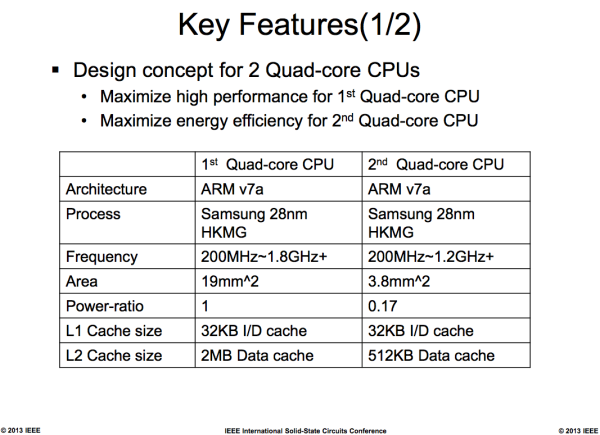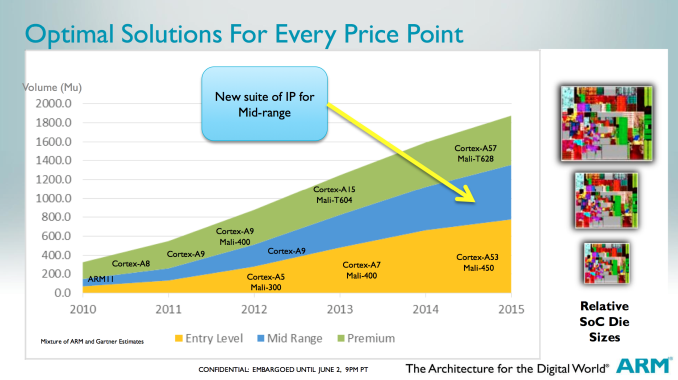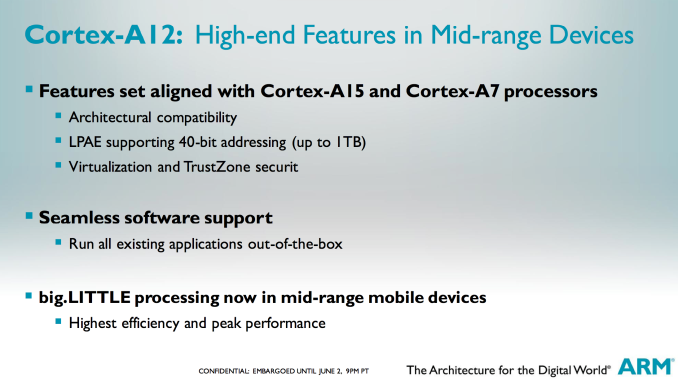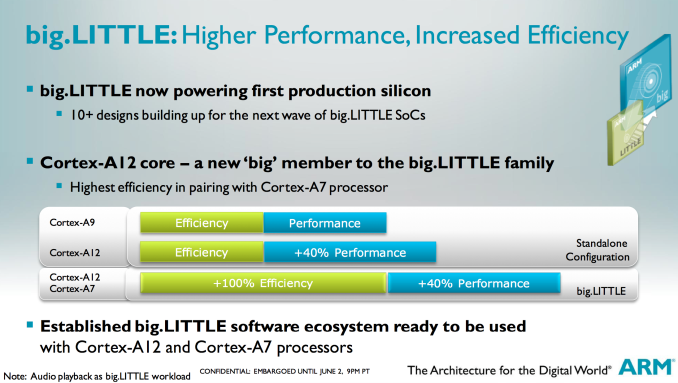ARM Cortex A12: Between Cortex A9 and A15 in Power & Perf, Sampling in Late 2014
by Anand Lal Shimpi on June 2, 2013 11:31 PM EST- Posted in
- Smartphones
- CPUs
- Arm
- Mobile
- Tablets
- Trade Shows
- SoCs
- Cortex A12
- Computex 2013

We’ve talked about the hole in ARM’s product lineup for quite a while now. The Cortex A9 is too slow to compete with the likes of Intel’s Atom and Qualcomm’s Krait 200/300 based SoCs. The Cortex A15 on the other hand outperforms both of those solutions, but at considerably higher power and die area requirements. The slide below from Samsung illustrates my point clearly:

The comparison point here is the Cortex A15 and Cortex A7, but the latter should be quite performance competitive with a Cortex A9 so the comparison is still relevant. The Cortex A15 island in Samsung’s Exynos 5 Octa occupies 5x the die area as the A7 island, and consumes nearly 6x the power. In exchange for 5x the area and 6x the performance, the Cortex A15 offers under 4x the performance. It’s not exactly an area or power efficient solution, but a great option for anyone looking to push the performance envelope.
Today, ARM is addressing that hole with the Cortex A12.
This announcement isn’t a deep architectural disclosure, but we do have some high level details to share. Like AMD’s Jaguar, Intel’s Silvermont and even ARM’s A9, the Cortex A12 is a dual-issue out-of-order architecture. Unlike the Cortex A9, the Cortex A12 is fully out-of-order including the NEON/FP units (NEON/FP was in-order on Cortex A9).
Pipeline length increased a bit compared to Cortex A9 (11 stages), however ARM told me to expect similar frequencies to what we have with the Cortex A9.
The execution back end has also been improved, although I don’t have many details as to how. My guess is we should expect something a bit wider than Cortex A9 but not nearly as wide as Cortex A15.
Memory performance is much improved compared to Cortex A9 as well, which we’ve already demonstrated as a significant weak point in the A9 architecture.
All of the architectural enhancements are supposed to provide up to a 40% increase in performance (IPC) over Cortex A9 at the same frequency and process node. ARM isn’t talking power, other than to say that it can do the same workload at the same power as a Cortex A9. In order words, Cortex A12 should have higher power than Cortex A9 but faster execution reduces total energy consumed. With a higher max power we’ll see more dynamic range in power consumption, but just not nearly as much as with the Cortex A15.
Cortex A12 also adds support for 40-bit memory addressability, an intermediate solution before we get to 64-bit ARMv8 based architectures. Finally, Cortex A12 features the same ACE bus interface as Cortex A7/A15 and can thus be used in big.LITTLE configurations with either core (but likely exclusively with the A7s). Given the lower power profile of Cortex A12, I'm not sure the complexity of doing a big.LITTLE implementation will be worth it though.
ARM expects the Cortex A12 to be used in mainstream smartphones and tablets where cost and power consumption are a bit more important. The design makes a lot of sense, the only downside is its launch timeframe. ARM expects to be sampling Cortex A12 in late 2014 with the first devices showing up in 2015. Update: ARM clarified that SoCs based on Cortex A12 would be shipping to device vendors in mid-2014, with devices shipping to consumers by late 2014 to early 2015. ARM has optimized Cortex A12 processor packs at both Global Foundries (28nm SLP) and TSMC (28nm HPM).













78 Comments
View All Comments
TheJian - Tuesday, June 4, 2013 - link
Agreed, considering the slide leaked a while back shows Nov15-Jan15 for production, how can you get into an xmas device in 2013? It takes 4.5+ months after an OEM gets a chip to make a device around it (only google has done it this fast so far). Heck if memory serves, that slide showed QA not even happening when they'd have to be SHIPPING to oem's for xmas 2013. devices. I'll be fairly shocked to see silvermont in a phone before late Q1 (if it makes it, they must have updated the roadmap without it leaking). Is Silvermont now shipping to device makers in Aug? I must have missed that news if so. This is why it was so important for T4/T4i to make it out the door ~early july. You can possibly get into Black friday stuff then...LOL which is basically like Christmas part1 right? :)psychobriggsy - Monday, June 3, 2013 - link
This product is presumably intended to replace the A9 in mid-range SoCs, which are the bulk of the market, and will still be relevant for several years to come in low and mid-range phones and other devices. No die sizes given though, probably a bit bigger than the A9 on the same node, but a lot smaller than the A15.I presume that ARM are also working on an as-yet-unannounced mid-range 64-bit part, probably called the A55, to go alongside the A53 and A57.
And until I see a review of Silvermont I won't be assuming that it is the be-all-and-end-all of mobile cores, unlike plenty of other people.
Krysto - Monday, June 3, 2013 - link
I believe you are right. Because 32 bit in mid-late 2014, doesn't make any sense. This feels like a stop-gap chip, and ideally they should've released the A53, "A55" and A57 in the same time, but it will probably arrive a year later - mid-2015, and be 10-15% faster than A12.Wilco1 - Monday, June 3, 2013 - link
What makes you think Silvermont will outperform the A12? We don't know until we see actual benchmarks, but my guess is their performance is similar. I don't see how Silvermont could outperform either Jaguar or A15 (let alone A57!) given it has just a single load/store pipeline and limited memory reordering.Homeles - Monday, June 3, 2013 - link
"What makes you think Silvermont will outperform the A12?"Saltwell cores already are pretty close to A15.
"I don't see how Silvermont could outperform either Jaguar or A15 (let alone A57!) given it has just a single load/store pipeline and limited memory reordering."
Clock speed. Intel's FinFETs are a huge advantage to them. Silvermont is supposed to come in at 2.0-2.4GHz (for dual core, at least). A 2.4 GHz Saltwell would be on the level of A15; multiply by the 50% IPC gains that Silvermont brings, and Intel's lead is clear.
Jaguar is in a totally different class on the high end of its spectrum, but Silvermont should do pretty well against it at the TDPs they compete in. Jaguar isn't quite cut out for tablets. Here, Intel's overwhelming frequencies will be what makes it competitive -- most Temash designs have a clock speed of 1GHz. The A6 Temash model does look very good, though.
Perhaps we'll see just how well Temash does in the near future...
Wilco1 - Monday, June 3, 2013 - link
Where is Saltwell performance close to A15 even with a 25% clock advantage? http://browser.primatelabs.com/geekbench2/compare/...The performance gap both single and multithreaded is just ridiculous. And these are current phone models...
As for clockspeed, A15 is currently at 1.9GHz, and the move to 20nm should give a good frequency boost, so A15 will have similar top frequency as Silvermont. However A15 will likely have a decent IPC advantage (given the gap with current Atom is huge) and thus will still outperform Silvermont when running at a lower frequency.
Jaguar certainly can't compete at lower TDP/clocks so in tablets A15 will prevail.
Wilco1 - Monday, June 3, 2013 - link
Here is what ARM says about A15 vs Silvermont: http://www.pcworld.com/article/2040582/arm-claims-...tech4real - Monday, June 3, 2013 - link
Comparing a top of line Galaxy S4 versus an old single core saltwell medfield isn't going to say much about how good A15 is core-for-core or iso-power performance against upcoming silvermont. And i don't even know how much difference 2GB ram vs 1GB ram is going to favor S4 in these test. Also as I mentioned before you can easily fall into a pitfall of doing a bad job of assess processor/soc perf and power if you are not careful about your test methodology.A15 at 1.9GHz? what's the power burn at that freq, how long does it have to throttle back to 600Mhz or less to cool down the phone? there are reports showing the octa core S4 throttles itself badly after maybe 30second use.
20nm move? This will take a while and it's interesting to see the power/perf and yield on TSMC this time. Everyone can paint pies in the sky, sometime it shows up more or less without big hiccups, sometime it can take a really long time (TSMC 28nm HPM, anyone?).
Wilco1 - Monday, June 3, 2013 - link
I don't believe dual core Atom phones are out yet, but Geekbench lists single-threaded results so you can compare core for core, and Atom comes out woefully bad against A15. RAM doesn't make a difference as there is no IO and Android doesn't do paging.Samsung claims about 5.5W for quad A15 at 1.8GHz. I haven't seen any reports that S4 throttles itself badly - Anand explicitly reported that he was only able to throttle it in one benchmark when running a set of benchmarks.
20nm is already ramping up, the rumour is that Apple will be the first customer. I'd certainly hope TSMC has learnt from the slow 28nm introduction.
wsw1982 - Monday, June 3, 2013 - link
Check lenovo K900, please.